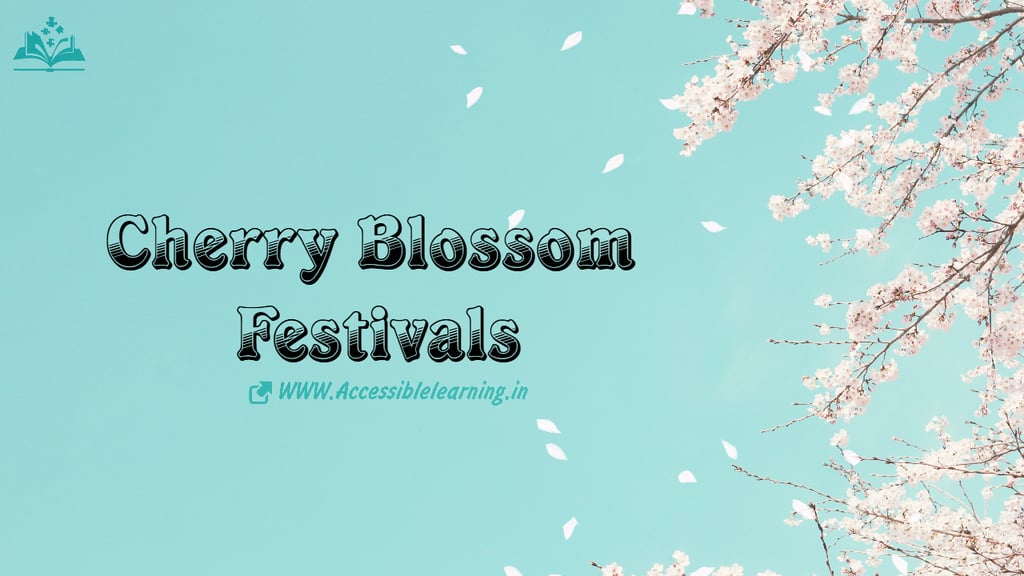
The Ancient Origins of Hanami: Japan's Cherry Blossom Tradition
Cherry Blossom Festival: Celebrating Spring's Ephemeral Beauty Explore the cultural significance, global celebrations, and timeless traditions of this breathtaking natural phenomenon.
EVENT/SPECIALSTORY/ENTERTAINMENTTRAVEL LIFECELEBRATION/FESTIVALSJAPAN
Kim Shin
3/6/20253 min read


Cherry blossom festivals represent one of spring's most enchanting celebrations worldwide, drawing millions of visitors to witness the breathtaking yet fleeting spectacle of blooming sakura. These festivals combine cultural heritage, natural beauty, and community celebration in a way that resonates deeply with participants across generations.
The Cultural Significance of Cherry Blossoms
Cherry blossoms hold profound symbolic meaning in Japanese culture, where they're known as "sakura." Their brief blooming period—typically lasting just one to two weeks—embodies the Japanese concept of "mono no aware," an awareness of impermanence and the bittersweet appreciation of transient beauty.
This symbolism extends beyond aesthetics; cherry blossoms represent renewal, hope, and the cyclical nature of life. Their arrival marks winter's end and spring's beginning, serving as both a calendar marker and a spiritual reminder.
Hanami: The Ancient Tradition
The practice of hanami (flower viewing) dates back to Japan's Heian period (794–1185), when aristocrats would gather beneath blooming cherry trees to compose poetry, drink sake, and contemplate life's fleeting nature. What began as an elite pastime gradually became a beloved tradition among all social classes.


Notable Cherry Blossom Festivals Around the World
National Cherry Blossom Festival (Washington, D.C.)
Washington's celebration commemorates the 1912 gift of 3,000 cherry trees from Mayor Yukio Ozaki of Tokyo to the American capital. Nearly 1.5 million visitors attend annually, enjoying parades, cultural performances, and the spectacular blooms around the Tidal Basin.
Jinhae Cherry Blossom Festival (South Korea)
South Korea's largest cherry blossom festival attracts over 2 million visitors yearly with its famous "cherry blossom road" at Gyeonghwa Station and illuminated evening viewings along Yeojwacheon Stream.
Sakura Matsuri (Japan)
Japan hosts numerous celebrations featuring nighttime illuminations (yozakura), traditional tea ceremonies, seasonal foods like sakura mochi, and the helpful "cherry blossom forecast" (sakura zensen) that tracks the blooming front as it moves northward.
Cherry Blossom Viewing Traditions
Japan: Picnic parties under trees with special bento boxes and sake
Korea: Romantic evening strolls under illuminated trees
China: Tea drinking ceremonies incorporating cherry blossom tea
United States: Photography tours and educational programs about Japanese-American relations
Photographic Opportunities
Dawn lighting creates a magical glow through delicate petals
Wind-scattered petals form natural "pink snow" (hanafubuki)
Contrast between blossoms and historical monuments creates iconic imagery
Macro photography reveals intricate details of individual flowers
Planning Your Cherry Blossom Experience
Research bloom forecasts specific to your destination
Book accommodations months in advance
Visit on weekdays when possible to avoid crowds
Bring appropriate photography equipment
Prepare for variable spring weather conditions
Interesting facts
The oldest cherry blossom tree in Japan is over 2,000 years old, located at Jisso-ji Temple in Yamanashi.
During World War II, many Japanese citizens viewed cherry blossoms as a patriotic symbol, with fallen blossoms representing sacrificed soldiers.
Cherry trees can bloom in autumn in rare cases of unusual weather patterns, called "jiki-zakura" (off-season cherry blossoms).
The initial cherry trees sent to Washington, DC, in 1910 had to be destroyed upon arrival due to insect infestation. The successful 1912 shipment contained 12 different varieties.
Cherry blossom viewing parties in Japan have their own forecast on national news, tracking the "sakura front" as it moves northward.
In Macon, Georgia, the International Cherry Blossom Festival celebrates over 350,000 Yoshino cherry trees—more than Washington, DC.
The tradition of sending cherry trees as diplomatic gifts has continued, with Japan gifting trees to numerous countries, including Brazil, Germany, and Turkey.
Cherry blossom petals are edible and used in traditional Japanese cooking for sakura mochi, sakura tea, and seasonal wagashi (sweets).
The Washington, DC, cherry trees have been cloned to preserve their genetic lineage against climate threats.
In Japanese culture, falling cherry blossoms symbolize the samurai ideal of a beautiful, brief life.
Cherry blossom festivals remind us that life's most profound experiences are often those we cannot hold onto—only appreciate fully in the moment. This celebration of ephemeral beauty continues to bring people together across cultural boundaries, inviting us all to pause and acknowledge the fleeting yet perfect nature of existence.
Subscribe to our newsletter
All © Copyright reserved by Accessible-Learning
| Terms & Conditions
Knowledge is power. Learn with Us. 📚


